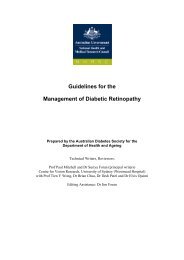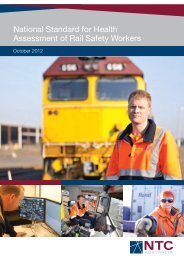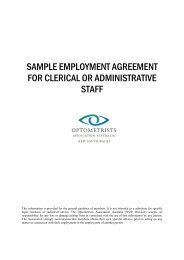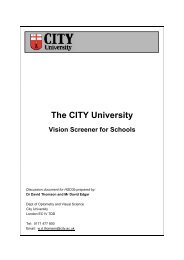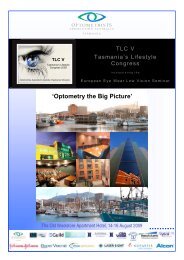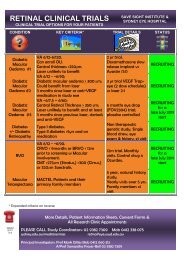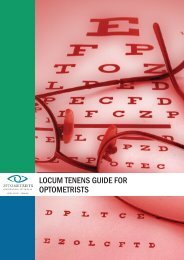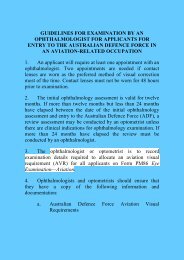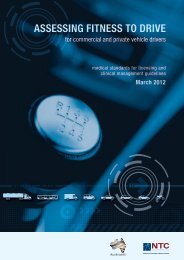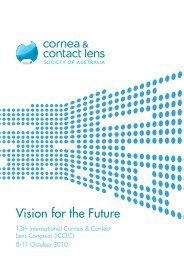Eye health in the workplace - a guide for PCBUs and ... - Comcare
Eye health in the workplace - a guide for PCBUs and ... - Comcare
Eye health in the workplace - a guide for PCBUs and ... - Comcare
You also want an ePaper? Increase the reach of your titles
YUMPU automatically turns print PDFs into web optimized ePapers that Google loves.
18<br />
WORK INVOLVING PHYSICAL<br />
RISKS OF EYE INJURY<br />
The majority of workers per<strong>for</strong>m<br />
work with little or no threat of<br />
eye <strong>in</strong>jury—examples of work<br />
with an elevated risk of eye<br />
<strong>in</strong>jury <strong>in</strong>clude:<br />
> us<strong>in</strong>g lasers<br />
> h<strong>and</strong>l<strong>in</strong>g hazardous<br />
chemicals<br />
> weld<strong>in</strong>g<br />
> solder<strong>in</strong>g<br />
> gr<strong>in</strong>d<strong>in</strong>g.<br />
Proper precautions should be taken to m<strong>in</strong>imise <strong>the</strong> risk of eye<br />
<strong>in</strong>jury. Equally important is <strong>the</strong> responsibility <strong>for</strong> both <strong>PCBUs</strong> <strong>and</strong><br />
workers to respond appropriately <strong>in</strong> <strong>the</strong> event of eye <strong>in</strong>jury.<br />
Although risks can be m<strong>in</strong>imised by <strong>the</strong> strategies of hazard<br />
elim<strong>in</strong>ation, hazard control <strong>and</strong> personal protection, accidents<br />
<strong>and</strong> eye <strong>in</strong>juries may still happen.<br />
Controls need to be <strong>in</strong> place to elim<strong>in</strong>ate or m<strong>in</strong>imise <strong>the</strong> risk of<br />
physical eye <strong>in</strong>jury. <strong>Eye</strong> <strong>in</strong>juries can occur from:<br />
> sudden impacts on <strong>the</strong> eye by external objects<br />
> penetration of <strong>for</strong>eign bodies—<strong>for</strong> example, spl<strong>in</strong>ters, dust,<br />
ash, bits of wood, metal, glass or o<strong>the</strong>r materials<br />
> exposure to high <strong>in</strong>tensity light, radiation—<strong>for</strong> example,<br />
microwave, <strong>in</strong>frared, ionis<strong>in</strong>g/non-ionis<strong>in</strong>g <strong>and</strong> ultraviolet<br />
radiation<br />
> hazardous substances of a type or <strong>in</strong>tensity that can cause<br />
damage to <strong>the</strong> eye—such as chemicals <strong>and</strong> <strong>in</strong>fectious<br />
substances.<br />
<strong>Eye</strong>sight screen<strong>in</strong>g <strong>and</strong> periodic monitor<strong>in</strong>g can assist <strong>in</strong><br />
establish<strong>in</strong>g a worker’s pre-<strong>in</strong>cident vision <strong>and</strong> monitor any<br />
changes <strong>in</strong> vision over time. <strong>PCBUs</strong> may choose to establish a<br />
worker’s pre-<strong>in</strong>cident vision <strong>in</strong> l<strong>in</strong>e with relevant st<strong>and</strong>ards.<br />
The level of vision prior to an accident should be <strong>the</strong> basis<br />
<strong>for</strong> evaluat<strong>in</strong>g any loss of sight. Determ<strong>in</strong><strong>in</strong>g impairment after<br />
an accident is much more efficient <strong>and</strong> certa<strong>in</strong> if vision prior<br />
to <strong>the</strong> accident is known. The Australian St<strong>and</strong>ard AS/NZS<br />
2211.1:1997: Laser Safety recommends that <strong>the</strong> vision of<br />
workers should be documented be<strong>for</strong>e commencement of work<br />
with lasers (AS/NZ, 2004). This pr<strong>in</strong>ciple could be extended to<br />
all workers whose occupation exposes <strong>the</strong>m to <strong>the</strong> risk of eye<br />
<strong>in</strong>jury (Cole, 2003).



